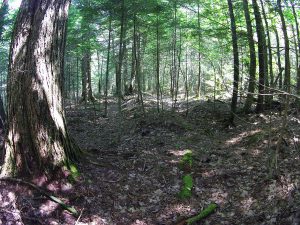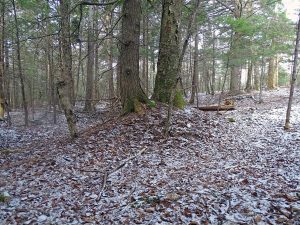My answer, Yes, if the blowdown is not removed (e.g. as a salvage harvest)
Posted Feb 4, 2019
Minor modifications Feb 6, 2019

Pit and Mound topography at Sandy Lake. Growing evidence suggests Pit & Mound Topography is a consistent feature of Old Growth in Nova Scotia, as in Maine
Click on image for larger version
The reasoning
It seems that it has been quite normal to have periodic blowdown of smaller to larger patches or stands of well established Old Growth forest in NS, one result of which is formation a “pit and mound” topography. The uprooted bases or the soil-covered mounds that form over time in turn are preferred ground for establishment of tree seedlings, and most of the big trees we see today in OG stands (or patches) are found on top of mounds.
The pits often develop as vernal (temporary) pools, providing habitat for amphibians and other organisms requiring water for part of their life cycle. As the trees grow old and mounds erode, the tree roots are exposed creating cavities for wildlife between the roots and the trunk. Trees snap off in a windstorm or just die in place providing “snags” that support another suite of wildlife, and when they fall over, another suite as they gradually return to and enrich the earth. So the blowdowns, smaller and larger, benefit the overall health of the forest.
Joe Rankin, citing Andrew Whitman at the Manomet Center for Conservation Sciences and Shawn Fraver, a professor at the University of Maine’s School of Forest Resources in “Old Growth” Forests Defined by Key Ecological Characteristics on Forests for Maine’s Future (Dec 20, 2016) thinks that Pit and Mound Topography is a defining feature of Old Growth in Maine:
One other telltale feature of an old growth forest is the forest floor itself, said Whitman and Fraver. It’s not, by any means, level. Instead it’s characterized by dips and mounds. Not coincidentally they’re more or less the size of a large tree’s root ball and its accompanying soil. This “pit and mound” topography occurs when old big trees are blown down, their roots upended. The mound is created by the exposed root ball, the hollow is where it once was. Gradually, over decades, the root rots and both the mound and pit are colonized by mosses, ferns, wildflowers and young trees.
“It could take an old field a thousand years to get that pit and mound topography,” said Whitman. “In managed forests you rarely get that, because large trees are cut before they can fall down”
The lack of pit and mound topography is a good indication that the land was once smoothed by the plow, even if it was a century or two ago. For Fraver, there’s one pretty sure indication that a forest wouldn’t qualify it as old growth. “If I see cut stumps that is evidence that it’s been harvested.”
I think there is a growing realization that a Pit and Mound Topography is also the norm in Old Growth stands or patches of Old Growth in Nova Scotia* and thus that blowdown and pit mound formation is a process to which our Old Forest species have adapted.
________________________

Dr. Elena Ponomarenko shows participants in the MTRI Old Forest Conference (Oct 19-21, 2016) how to read the forest floor to uncover past disturbances and forest types. Donna Crossland with soil corer at right, Bruce Stewart of NSDNR to her left (it is a DNR study site).
In that regard, we owe much to Russian born and educated* soil scientist Elena Ponomarenko, a resident of Ottawa for some time. Keji Park ecologist Donna Crossland brought her to NS in the 2000s to gain some insight into the history of disturbance regimes in Kejimkujik National Park, and Elena has visited many times subsequently, some of them on the behalf of NSDNR. I was lucky enough to attend a field workshop/lecture by Elena Ponomarenko and Donna Crossland at the MTRI Old Forest Conference in 2016, and subsequently applied some of what I learned there to informal studies of Old Growth in the vicinity of Sandy Lake (Bedford, NS). In the process, I discovered that retired DNR pest specialist Bob Guscott was conducting similar sorts of observations at Grand Lake and we began to collaborate, with frequent communication with and some direct collaboration of, Elena P and Donna C. *I mention her background because the Russians founded soil science and remain pre-eminent soil scientists, Elena Ponomarenko amongst them.
Hence my Answer to the somewhat rheotical question “If an Old Growth stand blows down, is it still Old Growth?”: Yes, if the blowdown is not removed (e.g., as a salvage harvest).
Some implications

Yellow birch growing on hemlock blowdown,
probably from Hurricane Juan
Click on image for larger version
This Q&A has some practical implications.
First, it suggests to me that a patch or stand that might not qualify as “Old Growth” under Nova Scotia’s Old Forest Policy* but that has perhaps a few trees older than 125 years, and many more at younger ages but all on pit and mound topography is really a stage in the normal dynamics of Old Growth, and so should be considered Old Growth.
_________________
* “Old Growth: A forest stand where 30% or more of the basal area is in trees 125 years or older, at least half of the basal area is composed of climax species, and total crown closure is a minimum of 30%.”
Second, to me it suggests that we should think twice about a salvage harvest of Old Growth trees blown down by hurricane force winds, or killed of by disease or pests, e.g., the Hemlock Wooly Adelgid. We certainly shouldn’t assume that such stands are best removed for the sake of the health of the forest*. Perhaps concern about fire would be a better reason but even then, we might ask “could we conduct a controlled burn of such a stand to preserve the Old Growth processes?” (Observations on mounds indicate that historical blowdowns have sometimes been followed by fire.)
____________________
*“‘Salvage harvest’ is a harvest prescription where merchantable timber is salvaged from an area after a natural disturbance (e.g. wind, insect infestation, fire) has caused detrimental effects to the health of the forest and before the majority of trees have started decomposing and are no longer merchantable.” – Forestry Maps Harvest Prescription Definitions in a message to subscribers of map-update notifications, Feb 4, 2019
Stuff to munch on, like the diverse beetles feeding on well decayed deadwood.
——————–
Some Links
Patterns of pedoturbation by tree uprooting in forest soils
Bobrovsky M.V., Loyko S.V. Russian Journal of Ecosystem Ecology Vol. 1 (1). 2016. A descriptive article with photos. It references classic research by E.V. Ponomarenko who has been working in Nova Scotia recently.
Woodlands shaped by past Hurricanes
By David Dwyer, Forester NSDNR. 1979
“Many of our forest stands in Nova Scotia are a result of past hurricanes. Mounds on the forest floor -the result of uprooted trees – indicate this. The age of trees growing on these mounds give a good indication of when the storm occurred. These stand ages compare well with the written records of past storms…”
Salvaging has minimal impacts on vegetation regeneration 10 years after severe windthrow
by AR taylor et al, Forest Ecology and Management Volume 406, 15 December 2017, Pages 19-27. “The study area was located approximately 50 km east of Halifax”. Includes discussion of pit and mound topography, disturbance regimes etc. Based on their observations, the authors concluded “Overall, salvaging had minimal effects on regenerating vegetation 10 years after windthrow and resulted in potential benefits, including increased mineralization of the forest floor, enhanced growth of seedlings, and improved access to conduct silviculture.” In the paper but not in the abstract: “further study is warranted to examine how physical changes to forest structure caused by salvaging may influence other forest attributes, including habitat and carbon stocks.” Also:
“From a nutrient sustainability perspective, salvage harvesting on the site type investigated can be considered similar to conventional clearcut harvesting in that the main concern is total nutrient removal over time (Keys et al., 2016), and harvest removals should not exceed cumulative inputs from soil weathering and atmospheric deposition (especially for Ca and N). Therefore, it may be important to retain some residual coarse woody debris after salvage harvesting to avoid potential future nutrient deficits.”
————–
**Added Sep 22, 2020:
Estimating retention benchmarks for salvage logging to protect biodiversity
Simon Thorn et al., 2020 in Nature Communications Published: 21 September 2020. “Forests are increasingly affected by natural disturbances. Subsequent salvage logging, a widespread management practice conducted predominantly to recover economic capital, produces further disturbance and impacts biodiversity worldwide. Hence, naturally disturbed forests are among the most threatened habitats in the world, with consequences for their associated biodiversity. However, there are no evidence-based benchmarks for the proportion of area of naturally disturbed forests to be excluded from salvage logging to conserve biodiversity. We apply a mixed rarefaction/extrapolation approach to a global multi-taxa dataset from disturbed forests, including birds, plants, insects and fungi, to close this gap. We find that 75 ± 7% (mean ± SD) of a naturally disturbed area of a forest needs to be left unlogged to maintain 90% richness of its unique species, whereas retaining 50% of a naturally disturbed forest unlogged maintains 73 ± 12% of its unique species richness. These values do not change with the time elapsed since disturbance but vary considerably among taxonomic groups.” Also view BEHIND THE PAPER: How much is enough? Protecting biodiversity in salvage logging disturbed forests by set-aside approaches
————–
Old Forests and Old Growth at Sandy Lake (Bedford, NS)
View
– sandylakebedford.ca>Forests
– sandylakebedford.ca>Forests> Mature/OG Forest
– sandylakebedford.ca>Forests>Pit & Mound Topography
– sandylakebedford.ca>Forests>Acadian Forest Love Affair
Pondering the PIT & MOUND TOPOGRAPHY at Oakfield Park, Nova Scotia (YouTube video) “Field-active” retirees Bob Guscott and David Patriquin discovered they share a passion for studying pit and mound topography in forests in the vicinity of Halifax, Nova Scotia.
What is Old Growth>OG Indicators
Pages on this website
Thanks for sensitive management of an old forest in Nova Scotia
Post Oct 8, 2018. “A few photos from the Conform Limited/NSWOOA field day (Oct 6) on “Harvesting the Old-Fashioned Way: Smaller Machines and Bigger Trees” say a lot about Conform’s and the woodlot owner’s efforts to harvest selectively in a mixed, multi-aged “overmature” stand…with pits and mounds”
———–
Please comment on NSFN content via WWNS; you can simply reference the content or URL* on NSFN in a post on WWNS. *For this post the URL is http://nsforestnotes.ca/2019/02/04/if-an-old-growth-stand-blows-down-is-it-still-old-growth/

